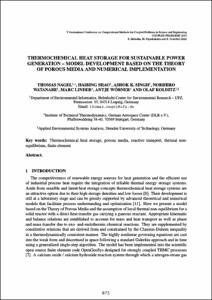Thermochemical heat storage for sustainable power generation – model development based on the theory of porous media and numerical implementation

Visualitza/Obre
Estadístiques de LA Referencia / Recolecta
Inclou dades d'ús des de 2022
Cita com:
hdl:2117/192637
Tipus de documentText en actes de congrés
Data publicació2013
EditorCIMNE
Condicions d'accésAccés obert
Tots els drets reservats. Aquesta obra està protegida pels drets de propietat intel·lectual i
industrial corresponents. Sense perjudici de les exempcions legals existents, queda prohibida la seva
reproducció, distribució, comunicació pública o transformació sense l'autorització del titular dels drets
Abstract
The competitiveness of renewable energy sources for heat generation and the efficient use
of industrial process heat require the integration of reliable thermal energy storage systems.
Aside from sensible and latent heat storage concepts thermochemical heat storage systems are
an attractive option due to their high storage densities and low losses [8]. Their development is
still at a laboratory stage and can be greatly supported by advanced theoretical and numerical
models that facilitate process understanding and optimisation [11]. Here we present a model
based on the Theory of Porous Media and the assumption of local thermal non-equilibrium for a
solid reactor with a direct heat transfer gas carrying a gaseous reactant. Appropriate kinematic
and balance relations are established to account for mass and heat transport as well as phase
and mass transfer due to exo- and endothermic chemical reactions. They are supplemented by
constitutive relations that are derived from and constrained by the Clausius-Duhem inequality
in a thermodynamically consistent manner. The highly nonlinear governing equations are cast
into the weak form and discretised in space following a standard Galerkin approach and in time
using a generalized single-step algorithm. The model has been implemented into the scientific
open source finite element code OpenGeoSys designed for strongly coupled THMC processes
[7]. A calcium oxide / calcium hydroxide reaction system through which a nitrogen-steam gas
mixture passes is taken as a model system. The simulations show a fast and a slow reaction
wave travelling through the reactor that are limited by system equilibrium temperature / heat
transport and the degree of conversion of the solid material, respectively. It is shown how the
system performance, e.g. in terms of outlet heat profiles, can be adapted to specific needs by
varying process and material parameters.
ISBN978-84-941407-6-1
| Fitxers | Descripció | Mida | Format | Visualitza |
|---|---|---|---|---|
| Coupled-2013-77_Thermochemical heat storage.pdf | 677,0Kb | Visualitza/Obre |

